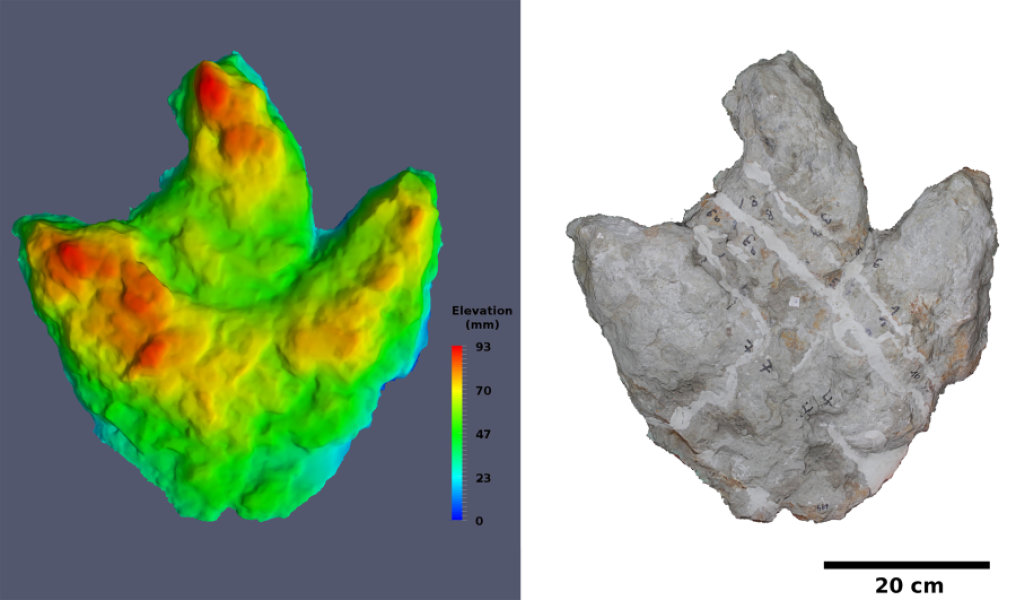Twelve years ago, footprints of carnivorous dinosaurs were discovered and excavated in a quarry near Goslar. Paleontologists from the University of Bonn, working with Dinosaur Park Münchehagen and the State Museum of Hanover, have now created a three-dimensional digital model based on photographs of the excavation. The reconstruction of the discovery site suggests that carnivorous dinosaurs hunted herbivorous island-dwelling dinosaurs about 154 million years ago. They believe the predators could have immigrated via a land bridge as sea levels dropped.
The findings have now been published in the geoscience journal Palaeontologia Electronica.
In 2003, a private fossil collector made a surprising discovery in a limestone quarry near Goslar in Lower Saxony: a total of 20 dinosaur footprints imprinted on a stone slab. Nils Knötschke, from Dinosaur Park Münchehagen, was able to salvage five of the tracks and kept them from being destroyed by the quarry work. Now, about a dozen years later, paleontologists from the University of Bonn, led by Prof. Dr. Martin Sander, have worked with Nils Knötschke and Dr. Oliver Wings from the State Museum of Hanover to reconstruct the tracks in a three-dimensional model, using digital methods. The project was based on photos of the tracks taken at the time when they were excavated.

Three-dimensional model of one of the largest footprint fillings. Left: Color-coded elevation model. Reds represent the highest points in the footprint, and blues represent the lowest points. Right: Three-dimensional model with photorealistic texture.
Credit: Jens Lallensack/2015
“Even five years ago, it wouldn’t have been technically possible to do this kind of reconstruction,” says first author Jens N. Lallensack of the Steinmann Institute for Geology, Mineralogy and Paleontology at the University of Bonn. Based on the 3D model, the researchers were able to gain crucial information about the dinosaurs that left the footprints behind, and about their habitat at the time. The tracks, measuring between 36 and 47 centimeters in length, probably represent two different species of predatory dinosaurs from the Theropoda group.
Glimpses of the habitat 154 million years ago
Based on the digital model, we can now see how the individual footprints are positioned in relation to one another. “That allowed us to reconstruct the moving direction, and how fast the animals were traveling. Based on the length of the footprints, we can estimate that the largest animals had a body length of about eight meters. In some places, the carnivorous dinosaurs also left much deeper tracks in the sediment than elsewhere. “Where the ground was soft, the dinosaurs sank in much deeper than where it was dry,” reports Lallensack.
About 154 million years ago, during the Late Jurassic Era, there was a shallow sea throughout this region, with small islands jutting up out of it. Bones found in the Langenberg Quarry confirm that the islands were inhabited by a species of small dinosaurs, Europasaurus holgeri. These herbivores belonged to the group of gigantic, long-necked dinosaurs called sauropods. However, a full-grown Europasaurus only measured six to eight meters — about one-fourth the length of its nearest relative, Camarasaurus. “The dinosaur probably had to shrink down to dwarf size in order to survive, given the limited food available on these small islands in the shallow Central European sea,” says Lallensack.
Theropods probably immigrated via a land bridge
The theropods that originally made the reconstructed dinosaur tracks came on the scene about 35,000 years later. “It’s possible that the sea level dropped during this period — a relatively short time from a geological perspective — and that the mainland carnivorous dinosaurs immigrated at that point,” surmises Dr. Wings, who is heading a research project funded by VolkswagenStiftung at the State Museum of Hanover on the overall Jurassic habitats of the region. The theropod tracks come from a dried-up ocean floor bed very close to one of the islands.
As a result, the researchers suspect that the predatory theropods came from the mainland in order to hunt the herbivorous Europasaurus. All of the limestone in the quarry formed in a shallow sea basin, as evidenced by the large number of marine fossils such as snails, mussels and sea urchins. To date, the tracks are the only indication that the region was temporarily dry, and that large mainland-based carnivorous dinosaurs were present on the former Europasaurus island. “We suspect that is what sealed the fate of these specialized island-dwelling dwarves,” says Lallensack.



 June 24th, 2015
June 24th, 2015  Riffin
Riffin  Posted in
Posted in  Tags:
Tags: 